Museums and Exhibitions in New York City and Vicinity
| Home | | Museum Guide | | International | | Architecture & Design | | Theater |
GLENN LONEY'S MUSEUM NOTES
CONTENTS, October, 2005
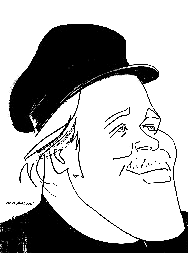
|
|
| Caricature of Glenn Loney by Sam Norkin. | |
Please click on
" * " to skip to each subject in this index:
At the Guggenheim Museum: *
RUSSIA! *
At the Asia Society: *
VIETNAM: *
Destination for the New Millennium: The Art of Dinh Q. Lê *
At the Metropolitan Museum: *
VINCENT VAN GOGH: The Drawings *
PRAGUE: The Crown of Bohemia: 1347-1437 *
THE PERFECT MEDIUM: *
Photography and the Occult *
The Art of Medicine in Ancient Egypt *
RARA AVIS: Selections from the Iris Barrel Apfel Collection *
MATISSE: *
The Fabric of Dreams—His Art and His Textiles *
At the New York Public Library: *
TREASURED MAPS *
"I am with you": Walt Whitman’s Leaves of Grass *
At the Dahesh Museum *
And the Princeton University Art Museum: *
THE LEGACY OF HOMER: *
Four Centuries of Art from the École des Beaux-Arts *
At the Frick Collection: *
Memling’s Portraits *
At the Museum of Modern Art: *
SAFE: Design Takes On Risk *
At the Whitney Museum of American Art: *
OSCAR BLUEMNER: A Passion for Color *
Robert Smithson’s Previously Unrealized Design-Project: *
FLOATING ISLAND TO TRAVEL AROUND MANHATTAN ISLAND *
Actually Does So in Early Autumn *
At the Cooper-Hewitt Museum: *
Yinka Shonibare Selects: *
Works from the Permanent Collection *
At the James Cohan Gallery: *
Yinka Shonibare: Mobility *
EXTREME TEXTILES: Designing for High Performance *
At the New-York Historical Society: *
SLAVERY IN NEW YORK *
At the Jewish Museum: *
THE JEWISH IDENTIY PROJECT: *
New American Photography *
At the Brooklyn Museum: *
MANUFACTURED LANDSCAPES: *
The Photographs of Edward Burtynsky *
STATUE OF LIBERTY: *
Now on View: Conservation Coming in Spring! *
At Galerie St. Etienne: *
SUE COE: Sheep of Fools *
FOR-SITE On-Site at the Excelsior Ditch Camp Road: *
[Closing January 11, 2006]
With the removal of Thomas Krens as director of the Guggenheim Museum—although he remains at the head of the Guggenheim Foundation—the public may have seen the last of the Epic Blockbuster Exhibitions of Motorcycles and Aztec Arts. There may be a few more of these in the pipeline, but the current Slavic Retrospective, Russia!, is certainly selectively exhaustive.
Under the Patronage of President George W. Bush’s close friend, Vlad Putin—President of the Russian Federation—many of the 275 art-objects on view on Museum Mile have never been shown outside the former Soviet Union. In fact, the range of art-works spans the centuries: Icons from the 13th century vie with Post-Modernist Images for public favor.
There are even some Komar & Melamid paintings mocking the old Soviet Pretensions, as well as vintage 20th century achievements by Constructivists & Suprematists. How about Natalia Goncharova and Kazimir Malevich? Currently the darling of Western Curators, Ilya Kabakov has a room on view: The Man Who Flew into Space.
Important Western artworks by Van Dyck, Rubens, Murillo, Watteau, and Chardin—collected by Peter the Great and Catherine the Great—are proudly displayed. My favorite object is a large bronze full-armored bust of the Great Peter!
The great private Russian collectors, Sergei Shchukin and Ivan Morozov, are represented with works they acquired, including some major French Impressionists, once hidden away in the attics of the Hermitage. [When I first visited the Hermitage, back in 1956, one had to make a special request to see these canvases. Otherwise, their existence would not be mentioned by the museum-guides.]
Now everyone can see a wonderful range of Russian artworks and Russian collections of art masterpieces, without Soviet Restrictions or Censorship! This is obviously thanks to the efforts of Thomas Krens, not to overlook the Vladimir Potanin Charity Fund, the Alcoa Foundation, and Sintezneftegaz.Co.
Destination for the New Millennium: The Art of Dinh Q. Lê
[Closing January 15, 2006]
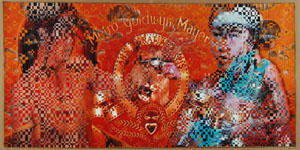 |
| Untitled from the series "From Vietnam to Hollywood by Dinh Q. Le |
The American novelist, Thomas Wolfe, insisted—at book-length—that You Can’t Go Home Again. But that is exactly what Dinh Q. Lê has done. He was born in Vietnam, but his family escaped to America. Educated in the United States, he returned to ‘Nam in the 1990s.
This Return & Rediscovery of his homeland has helped him produce an unusually varied body of work. Outstanding examples are now on view at the Asia Society on Park Avenue, a long way off from Ho Chi Minh City…
The bitter legacy of what Vietnamese call "The American War" is raised to the level of artworks in several of his pieces, notably some colorful small sculptures of co-joined twins and kiddies with multiple arms. This is the Legacy of Agent Orange. He calls these works Damaged Gene.
Using traditional grass-mat weaving-techniques, Lê has interwoven enlarged strips of journalist-photos of the war with digitally enhanced Hollywood images of warfare. These produce an astonishing optical effect.
In an effort to find family photos—abandoned when his family fled the beleaguered country— Lê has gathered many, many photos from other Vietnamese, with notations on their back. These he has linked to form a giant "story-quilt," which he has titled: Spending One’s Life Trying To Find One’s Way Home.
There’s also a room-installation of space-satellite-inspired steel & mirrors: From Doi Moi to the Sky.
On view in the Asia Society lobby are some handsome Laotian silk-weavings: Beyond Tradition: Carol Cassidy Woven Silks of Laos.
VINCENT VAN GOGH: The Drawings
[Closing December 31, 2005]
The distinctively strong, thick brush-strokes of Vincent van Gogh’s paintings set them instantly apart from the works of such contemporaries as Gauguin and Matisse. But few casual visitors to major art-galleries can realize how much these techniques owe to Van Gogh’s deft, detailed drawings, with their bold and powerful lines.
Now, for the first time in the United States, a major show of his drawings—some 113 of them—at the Met make very clear how important line was to him, as opposed to spatial areas and color. He seems to have been first a draftsman, who later filled in the lines with bold colors.
In fact, Van Gogh said that "drawing is the root of everything."
The current exhibition not only demonstrates his evolution as a draftsman—culminating in some very powerful visions just before he shot himself. But it also juxtaposes some of his oil-paintings with line-drawings that preceded them. This is very instructive.
In some cases, the drawings seem more powerful. Several key-motifs are featured—with a painting and three pen & ink renditions: Boats at Sea, Saintes-Maries-de-la-Mer, and Arles: View from the Wheat-Fields.
There are some 1,100 Van Gogh drawings known, and a number in the Met’s exhibit are on loan from the Van Gogh Museum in Amsterdam. Others come from major museums and private-collections.
Many of the works on view were created in the two final years Van Gogh worked in Provence, especially in Arles.
PRAGUE: The Crown of Bohemia: 1347-1437
[Closing January 3, 2006]
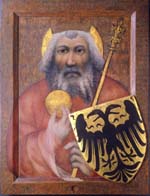 t
Saint Charlemagne by Master Theodonic. Photo by Jan Divis. t
Saint Charlemagne by Master Theodonic. Photo by Jan Divis. |
Seldom has so much precious golden artwork been shown at the Met Museum. The Treasury of St. Vitus Cathedral obviously contains some of the most remarkable examples of the goldsmiths’ arts in Central Europe. And these treasures are seldom on view—and almost never to be seen outside Prague.
In the current exhibition, there are a number of Golden Head Reliquaries, not to mention golden Monstrances, sacred books bound in gold, and royal golden regalia. The insurance must have cost a fortune…
Although Prague has had later eras of power and artistic achievement, the advent of Charles IV—crowned King of Bohemia in 1347—was the first time that this fabled city achieved renown. Charles oversaw the founding and construction of St. Vitus, the Veits-Dom. He founded the first university in Central Europe: Karl Universität.
Although the great Hrad—on the castle-hill by the cathedral, high above the Karl-Bridge and the River Moldau—was later the Royal Residence and remains today the Presidential Seat, Castle Karlstein, outside Prague, was the residence of King Charles and his two sons and successors, Wenceslas IV and Sigismund. [Its high courtyard is even today the summer scene of an historical pageant, Nights at Karlstein, with music by Dr. Antonin Dvorak!]
As a number of the Bohemian-Carolingian Treasures have been dispersed over eras—some to Vienna, as the Habsburgs gained ascendancy over Bohemia: Rudolf made Prague his capital at one time—loans have come from varied sources. There are 160 objects now at the Met, and they will surely never again be shown together.
Among the priceless artifacts are an icon Charles brought from his pilgrimage to Pope Urban in Rome and a rock-crystal reliquary to contain the Tablecloth from the Last Supper! [If you thought Jesus and His Disciples ate off bare boards, think again!]
Impressive religious paintings, silk-embroideries, illuminated manuscripts, stone & marble sculptures, stained-glass, jewelry, richly woven fabrics: the catalogue is bursting with colorful illustrations of these marvels.
[Closing December 31, 2005]
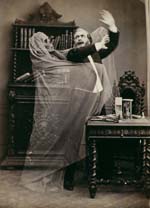 |
| Henry Robin and Spector |
Sherlock Holmes’ creator, Sir Arthur Conan Doyle, was hardly the only Victorian fascinated by the Paranormal and photographs of its manifestations. But he was certainly the most famous—if not certifiably the most credulous.
With the invention of photography, for the first time it seemed possible to make some kind of "scientific" record of the appearance of spirits of the dead in medium-invoked Séances. This odd and unusual photo-show offers a variety of visual testimonies: some to the fierce Will To Believe, others to the ingenuity of fraudulent Mediums, capitalizing on the grief of bereaved family-members.
We seldom hear about Ectoplasm any more, but, at one time, it was fairly common in conversations about what might lie beyond the grave and how people might contact the spirits of those who had passed on.
In the Met’s vintage photo-show, there are a number of shots of mediums in trances, with white cords or blobs of white ectoplasm oozing from their mouths or other bodily openings & exits. Some of these, alarmingly, show long ropes of the stuff snaking out from lady-mediums’ privates—covered, of course, by their long black gowns.
That a photographer should be able to capture the wispy image of a spirit—or even a skeleton—behind or beside a living human-being on a photographic-plate suggests some very ingenious Victorian artwork in the darkroom.
The unmasking of some of the frauds depicted here is discussed in wall-texts, but, in their time, these photos amazed many. For some, they were Proof-Positive of Life After Death and that beloved Mothers, Wives, or Grannies were still watching over those they’d left behind.
Could it be that disappointments of some clients of Clairvoyants led to the formulation of that old phrase: Striking a Happy Medium?
[Incidental Commentary: When I was very young, I knew an old Tuscarora Indian Chief who had Pocohontas, no less, for his Spirit Guide. She was supposed to help him find Gold in the High Sierras. This never worked out, but he dug a lot of tunnels, as did my father, who also believed. And, once upon a time in Key West, I attended a séance that was more of an entertainment than a Revelation.]
The Art of Medicine in Ancient Egypt
[Closing January 15, 2006]
 |
| Pomegranate Jars |
This is a small-scale but tremendously informative exhibition of over sixty ancient testimonies to the practice of protection from illness and processes of healing in Pharaonic Egypt. The centerpiece, the Edwin Smith Surgical Papyrus—on loan from the New York Academy of Medicine—is one of only two complete medical manuscripts from ancient Egypt, dating sometime between 1650 and 1550 BC. This has not been exposed to the public for half a century.
The remainder of the manuscripts, drawings, carvings, and objects are drawn from the Met’s own collections. They are not only very instructive—thanks to the wall-texts that interprete them—but they are also handsome to behold.
Notable are statues of the lion-headed Goddess of Healing, Sekhmet, and Imhotep, identified by the Greeks with Asclepius, the Greek God of Medicine. Also important: The Metternich Stela, featuring incised images and texts dealing with protection and healing.
RARA AVIS: Selections from the Iris Barrel Apfel Collection
[Closing January 22, 2006]
If you have never heard of Iris Apfel—when names like Chanel, Mainbocher, Dior, Valentino, Dolce & Gabbana, or De la Renta are bandied about—it may be because she is a couture and accessories collector and style-setter, rather than an actual couturier. She is also a very charming and knowing expert on costumes and clothing, and her marvelous outfits now on view in the Met’s Costume Collection Galleries are promised gifts to that excellent repository.
What is most amazing—and also at times amusing—is the ingenious way Iris Apfel mixes the highest of High Fashions with almost off-the-rack clothing items. And then accentuates these ensembles with gaudy costume-jewelry and semi-precious gems.
Some of her finds are handsome traditional costumes and jewelry from around the world. Others could have been found in a Thrift Shop. But, ingeniously combined and often layered, they add up to a wild variety of very impressive outfits!
The Fabric of Dreams—His Art and His Textiles
[Closed]
This necessarily Very Colorful Show was on view during the summer, closing just as your reporter was returning from Europe. Nonetheless—as it still exists in the form of the exhibition catalogue—it deserves some attention. Many of Matisse’ canvases are veritable riots of colors and patterns, often specifically inspired by actual garments or textiles.
Perhaps this was embedded in the Matisse DNA: his family had been involved in the design and manufacture of fabrics and textiles for generations in Northeastern France. Even as a poor student in Paris, he collected fabrics for their weaves, colors, and patterns.
Later, his Nice studio was crammed with exotic costumes and wall-hangings. And toward the close of his life—when his sight was impaired—his immense single-color cut-outs were also inspired by textile designs and patterns.
After his death in 1954, his family packed his fabric and costume collections away in trunks. He called these materials his "working library." This exhibition marked the first time that they had been widely seen by the public.
What is most important, however, is that they were shown alongside drawings and paintings that actually included some of the colorful costumes or fabric patterns on display. Some 35 textiles and costumes were on view, plus 45 paintings and over thirty drawings and prints.
Some of his Odalisques were shown, alongside North African costumes he used on his models. They are generally reclining on patterned carpets, cushions, and cloths.
Exemplary paintings—together with inspiring fabrics—included Still Life with a Blue Tablecloth, from the Hermitage Museum; Woman in Blue, from the Philadelphia Museum of Art, and Purple Robe and Anemones, from the Baltimore Museum.
The catalogue bears the same title as the exhibition. Published in London by the Royal Academy of Arts, it is available from the Met shops.
At the New York Public Library:
[Closing April 9, 2006]
 |
| New York State Map |
The impressive Map-Rooms of the New York Public Library—at 42nd Street & Fifth Avenue—have been undergoing complex restorations. They are scheduled to re-open in late autumn. Meanwhile, some of the treasures of this definitive collection are on view in the Edna Barnes Salomon Room.
There are ten divisions to this show, beginning with Ways of Looking at the World, showing how early map-makers tried to depict the then known—and, in some cases, the imagined—World. The Ancient World from Africa to Asia, the second section, shows how much and how little was then known about the Continents and their coast-lines—very important for navigators.
Tools of the Trade, the third section, explores the ways in which maps were created and the instruments that made them possible. Map-collectors will surely salivate over the almost priceless Renaissance maps of the Blaeu Family of Amsterdam, displayed in The Continental Tour: Europe. In the fifth section, the tour of North America, you can see California drawn as an island!
The remaining sections of this intriguing and informative exhibition deal with New York City and Manhattan Island in particular. It is fascinating to see how Manhattan—as well as the Boroughs—has evolved from its earliest days as a Dutch Settlement. And how Subway Maps have changed over the years!
For the Record: the NYPL’s graphic collections are housed in The Lionel Pincus and Princess Firyal Map Division!
"I am with you": Walt Whitman’s Leaves of Grass
[Closing January 8, 2006]
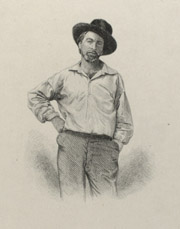 |
| Frontispiece engraving of Walt Whitman, by Samuel Hollyer |
This is not only a small-scale exhibition; it’s also a dimly-lit show, to protect the precious Whitman manuscripts of this Long Island school-teacher’s first book of poems, Leaves of Grass. When it was initially published, in 1855, it astonished—and, in some cases, outraged—lovers of poetry and literary-lions. Whitman’s odd mixture of unabashed American fervor, sexual celebration, and spiritual musings was something entirely new in American Letters.
Over the years, Whitman continued to work on Leaves, adding poems and emending originals. There are at least nine versions, in ten editions! The current exhibition tracks much of this, including vintage photographs of the notoriously un-shy poet. Self-promotion was second-nature: it was written into his verses!
What remains astonishing is the fact that Whitman had only six years of schooling, and yet his poems are certainly those of a well-educated and very self-aware talent. As for his school-teaching out on Long Island, the one-room school he presided over was for many years after referred to as "Old Sodom." This was thanks to Whitman’s reputation as celebrator of Male Love.
And the Princeton University Art Museum:
Four Centuries of Art from the École des Beaux-Arts
[Closing January 22, 2006]
Manhattan’s Dahesh Museum specializes in showcasing masterworks of Academic Salon Painting. Thus it proves an ideal venue for showing treasures from the Paris collections of the École de Beaux-Arts. The collections are, however, so extensive, and the theme of this show so grand, that it has been divided between New York and Princeton University.
In the 19th century, Historical Painting was the favored genre of the French Academy, as well as of its English counterpart. But even in the centuries preceding, subjects from Classical Antiquity were the core of training for young Parisian painters and sculptors at what was to become the École National Supérieure de Beaux-Arts.
The two-section exhibition offers some 130 paintings, sculptures, drawings, and prints from the École’s collections—which have been closed to the public since 1968. Many of these treat scenes from Homer’s Iliad and Odyssey, as well as tales from classical Greek mythology.
Most of these period artworks were created for school-competitions or acceptance into the Royal Academy of Painting and Sculpture. Spanning four centuries of French painting and sculpture, they show how the great Greek Heroes were depicted in a succession of styles: Baroque, Rococco, Neoclassical, & Romantic.
In modern times, artists and critics began to complain of the "Dead Hand" of the Academy on artistic inspiration and style. And, indeed, the Dahesh segment of this show does suggest that certain visions of the fabled characters and their celebrated actions held sway for more than three-hundred years!
Among the Homeric artists on view in Manhattan & Princeton are Jacques-Louis David, Nicolas Poussin, Jean-Baptiste Carpeaux, Honoré Daumier, & Jean-August-Dominique Ingres. David’s great canvas, Andromache Mourning Hector, anchors the Dahesh show.
There is also an ancillary exhibition at the Dahesh of 18th and 19th century editions of Homer’s epics, translated into various European languages.
[Closing December 31, 2005]
If you miss this handsome show of Medieval Faces, you can see some of the most impressive of Hans Memling’s portraits at home in the ancient City of Bruges, in Belgium. One of these is the ingenious Diptych of Maarten van Nieuwenhove, on loan from Bruges’ venerable St. John’s Hospital, founded in the 12th century.
Memling has long been admired for the naturalness of his sitters: these do not look like stylized gothic visages, but real people. The wealthy young Maarten—who commissioned the diptych for the chapel of St. John’s—is shown filling almost the entire left panel, facing a smaller Blessed Virgin, holding the naked Holy Infant on the right panel.
Family arms and symbols are shown in transparent stained-glass windows. In the background of the Virgin’s portrait is very small bulls-eye mirror: this reflects the details of both panels. Shown flat on the Frick’s wall, this would seem an optical impossibility, but the two hinged panels are meant to be seen at angles to each other: then the effect is astonishing.
There is a puzzling detail in Memling’s The Virgin and Child with St. Anthony Abbot and a Donor—on loan from Canada’s National Gallery—that must be a secret symbol. The donor is kneeling on the left side of the standing BVM. Right behind him, with a hand on his shoulder, stands St.Anthony. But down below, peeking out around the hem of the good Abbot’s gown is a pig’s head! Who let this swine into the Virgin’s chamber—and why?
Leading museums have lent Memling portraits, as well as those on loan from Bruges. Almost 2/3 of the extant Memling portraits—some secular, some religious—are on view at the Frick. This show, already seen in Madrid and Bruges, is unlikely to be repeated.
At the press-preview, the Belgian Tourist Office provided Belgian chocolates, tasty Speculatius cookies, and a handsome publication about the history and artworks of St. John’s Hospital. Art critics were urged to come to Bruges to see some of these glowing portraits in situ.
As Bruges was recently the Culture City of Europe, its many medieval buildings have been wonderfully refurbished—even gilded, in some cases. Picturesque canals run through the ancient city: a field-day for photographers!
Bruges has a majestic medieval gothic tower, with a clanging carillon. It also has the famed Chapel of the Holy Blood, where a crystal vial of Christ’s Blood from the Crucifixion is preserved! And they even have a Pageant of the Holy Blood to celebrate this Pilgrimage Wonder.
[Closing January 2, 2006]
Although most of the objects, devices, and fabrics on display in SAFE are colorful and smartly designed, this installation at MoMA looks more like a Trade-Show than an art-exhibition. It should be seen in tandem with the Coooper-Hewitt’s current EXTREME TEXTILES: Designing for High Performance.
Those who enjoyed Gregory Colbert’s large-scale sepia photos in Shigeru Ban’s Cargo-Container museum last spring on that West Side pier will be interested to see his safe little cabin made of rolled paper logs, a Signature-Shigeru-Material.
Conceived before 9/11 as Emergency—focusing on Emergency Response equipment—curator Paola Antonelli extended it afterward to "a wider definition of risk," and how designers have responded to the public’s "emotions about safety."
There is a small-scale helicopter hanging in the air, plus a small car, the Nida, on the order of the Smart Car. Other items include the Bracelet of Life, the Watercone, an Urban Nomad Shelter, the Mojo Barrier, a Stop Thief! Ply Chair, the Shapla Arsenic Removal Filter, a Guardian Angel Handbag, and Capsters Sports Headgear for Muslim Women.
Well, you get the idea…
At the Whitney Museum of American Art:
OSCAR BLUEMNER: A Passion for Color
[Closing February 12, 2006]]
The Whitney Museum has a sort of subtitle for its supercharged show of Oscar Bluemner’s unbelievably colorful canvases: An American Modernist Rediscovered!
Frankly, I had never heard of him, nor seen one of his dazzling paintings. This is not so surprising, as, in his own time, his work was not well received by New York art-collectors or critics. Only Alfred Stieglitz really appreciated what Bluemner was creating—and supported him with encouragement and gallery-shows, though little sold.
Actually, Bluemner was not a native American. He was born in Prussia and studied architecture in Berlin. In fact, he won the Royal Medal of Architecture in 1891! He fled to America, fearing the increasingly nationalistic attitudes of Kaiser Wilhelm, as well as the growing conservatism in German culture.
Oddly enough—for a painter who is only now being recognized for his special genius— Bluemner worked as an architect for his first 20 years in New York. His handsomely conservative architectural renderings—some of which are on view at the Whitney—look nothing like his brilliantly-hued paintings.
His Bronx County Courthouse—for which a Tammany Hall hack claimed credit—was one of his most famous/infamous commissions.
As a result of his court-case about the courthouse and his disgust with the way architecture had to be practiced—and with a settlement from the successful case against the hack— Bluemner spent some time in Europe, notably studying the innovations of German Impressionists, as well as new experiments in France and England.
From the bold strokes of bright colors in various paintings on view at the Whitney, it’s clear that works of the artists of the Blaue Reiter, Die Brücke, and Secession gave him some new ideas about visualizing nature on canvas.
Bluemner’s brilliant landscapes and city-scenes, however, are almost geometric reductions of the real thing: virtually stained-glass-bright color-abstractions of reality! They are amazing!
But it’s sad to learn that poverty dogged him, leading to his wife’s death, which sunk him into grief and melancholy. Neither the general public nor important collectors were interested in owning his paintings. Most were unaware of him and his unique vision.
Only with the execution and exhibition of his Compositions for Color Themes did he begin to receive critical notice. But he was now 70 years old. After auto-accident, he was stricken with stomach, eye, and heart-disease. Soon, he was unable to sleep or to walk or to see…
He committed suicide in 1938.
Fortunately, these remarkable paintings remain as colorful testimonies to his unique vision of America.
Robert Smithson’s Previously Unrealized Design-Project:
FLOATING ISLAND TO TRAVEL AROUND MANHATTAN ISLAND
Actually Does So in Early Autumn
When the Whitney Museum recently showcased various constructions and projects of the late Robert Smithson, one of his project-drawings excited especial interest. This was his idea for having a tug-boat tow a barge planted with trees around Manhattan Island.
This was finally realized in September, thanks to the cooperation of Minetta Brook and the Whitney. Down at the World Financial Center, stock-brokers were astonished to look out their windows and see the Little Tug That Could dragging a tree-laden barge after it.
And there was a Big Celebration—with drinks and snackies—down at Pier 46, with the tug & barge coming into view in the dusky sunset for a brief circuit. From Saturday, September 17, to Sunday, September 25, the water-borne fake-island trolled around the Hudson & East Rivers for the benefit of those with window-views or walking-shoes.
And why not? There is so much Ugliness in the World. Better to Tow a Barge than Curse the Dark!
Works from the Permanent Collection
[Closing May 7, 2006]]
Peter Cooper’s heiresses, the Hewitt Sisters—Amy, Eleanor, & Sarah, traveled extensively. And they brought back an amazing array of collectibles and oddments. For a long time, their eclectic collections were on view on the top floor of Cooper Union, down in the Village.
Trying to devise some system of organization for these treasures—wall-papers were a Hewitt fixation—curators finally decided to focus the Cooper-Hewitt Museum on various aspects of Design: Color, Line, Form, etc.
When the collections were removed to the Andrew Carnegie Mansion on the Upper East Side, this curatorial segmentation received the blessing of the Smithsonian Institution, which took the museum under its Administrative Wings, so to speak.
Since that move, the museum has mounted a variety of innovative exhibitions keyed to various Design Issues. These are, of course, expensive to devise and execute—and often involve the importation of objects and materials not in the museum’s own holdings.
But how to find a unifying theme to show off the Sisters’ wallpapers, pen-wipers, fly-swatters, and bird-cages?
The on-going solution is to invite Guest Curators to choose a theme and pick objects and artifacts from study-storage for a show. And the Nigerian-born, London-based artist, Yinka Shonibare, has obliged handsomely.
As the Hewitts traveled so much, Shonibare has chosen Travel & Transportation as his organizing theme.
Among the amusing and eclectic objects on view is a Birdcage in the form of Venice’s Rialto Bridge. And, of course, there is some wall-paper linked to travel. Various prints and photos celebrate travel and transport.
Most impressive is Shonibare’s own artist-imprint on the show. Towering over the objects are headless models of sisters Eleanor and Sarah, mounted on stilts and dressed in smart Victorian travel-garments made of Shonibare-designed "pseudo-African" batiks.
[Closing October 29, 2005]
Extending the Travel & Transportation theme of his Cooper-Hewitt show, Yinka Shonibare has some impressive creations on view at the James Cohan Gallery.
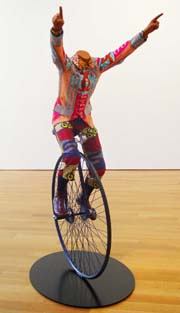 |
| Child on Unicycle by Yinka Shonibare. Photo courtesy of James Cohan Gallery, New York. |
There are three headless Victorians on unicycles, dressed in some wildly colorful outfits, each made of several distinctive Shonibare-designed "pseudo-African" batiks. They are fixed in place, but as posed, they look ready for some crashes.
This is both amusing and eye-arresting, but it also has Political Implications!
A Quote: "Through the use of subtle detail, Shonibare suggests notions of upward or downward mobility in collision with colonial and capitalist activities." Oh…
Shonibare’s other Cohan installation, Reverend on Ice, is his own headless version of Sir Henry Raeburn’s Portrait of the Reverend Robert Walker Skating. The original—which shows the sober black-clad, knee-breeched, long-coated Scots Minister, arms folded serenely, skating along on his left foot, on a frozen loch near Edinburgh—hangs in the National Gallery of Scotland.
Shonibare’s own Headless Parson—costumed in his colorful batik-fabrics—is shown on ice as well! The artist was: "…attracted to the multiple incongruities in this image, conflating the disparate worlds of Europe and Africa, as well as the sacred and the joyously profane."
This formulation seems rather odd, as nowhere in Raeburn’s stylish painting is there even a hint of the African coastline…
EXTREME TEXTILES: Designing for High Performance
[Closing October 30, 2005]]
This well-woven show could be a sister to MoMA’s new trade-show, SAFE. It also features fabrics, textiles, webbings, weavings, barriers, membranes, cables, and ropes specially woven of special materials to provide maximum strength, support, and protection in a variety of Industrial, Spatial, Sports, and Human Applications!
The exhibition’s Bottom-Line, curatorially-speaking, of course—is that the various items, swatches, patches, and objects on display do demonstrate Modern Design-at-Work. And they certainly exemplify not only effective functional usages, but also such desirables as Smart Colors, Lines, Silhouettes, & Forms!
At the New-York Historical Society:
[Closing March 5, 2006]
It may not be too extravagant a claim to suggest that New York City—or at least Manhattan—was built on foundations of Slavery. The ingeniously-designed interactive exhibition now at the New-York Historical Society certainly documents a History of Metropolitan Slavery previously unknown to most New Yorkers.
Before the American Revolution, 40 percent of NYC households owned slaves. Indentured black slaves made up 20 percent of the city’s entire population. This compares very unfavorably with Boston’s 2 percent and Philadelphia’s 6 percent.
In 1776, there were more slaves in New York than in any other American city—except Charleston, a major port in the Slave Trade.
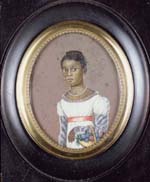 |
| Euphemia Toussaint |
Among early Manhattan Landmarks built by slaves: Trinity Church, Fraunces Tavern, Wall Street’s Wall, Fort Amsterdam on the Battery, and the first City Hall!
When Colonial Americans clashed with British troops, in the opening salvoes of the Revolution, New York slaves fled to enlist in the British Army, where they were given their freedom and fought valiantly.
Finally, New York’s slaves were definitively freed more than 30 years before Lincoln signed the Emancipation Proclamation—a manuscript copy of which is now on display at the Society! Under heavy guard…
The current exhibition displays a number of important and relevant early paintings & maps of Manhattan, both under the Dutch and the British. There are over 100 original artifacts dealing with various aspects—and personalities—of Slavery in New York. Manuscripts, sketches, portraits, and records are also on view.
The design of the various installations is also very imaginative: wire-sculptures evoke early events and people.
There are more than a dozen of multi-media presentations, plus five computer-interactive Learning Stations. There’s even a Talk-Back Station for post-viewing comments. And of course there’s a website: www.SlaveryinNewYork.org
[Closing January 29, 2006]
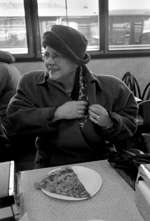 |
| La conversion de Carmen (Carmen's Conversion) by Jaime Permuth |
Perhaps it’s a mistake to commission artists to create works for a specific exhibition? This may engender the irritating anxiety of having to come up with an idea, an object, an installation, or even an artwork that may not represent your most original thoughts, visions, passions, or skills.
In the current show at the Jewish Museum, thirteen soi-disant artists were in fact commissioned to produce ten photography, video, or multi-media projects. The results are decidedly uninspiring, even uninteresting, unimaginative, and hardly Cutting-edge Innovative.
Perhaps too many of these artists have been watching too much television, hence the banality or obviousness of some of the photos and videos?
Witnessing too many over-praised and often appalling artist-videos at the Whitney Museum could also persuade someone with a SONY that he or she can just turn on the camera and gyrate in front of it.?
These 13 artists were asked to "challenge conventional ways of representing Ethnicity." Maybe it would have been more instructive to mount examples of photos curators consider "conventional" alongside these new prints, so viewers could judge for themselves what the experts regard as conventional, in comparison with Challenge-Meeting?
As this show is understandably Jewish-themed and funded, the artists were asked to explore Jewish Diversity in the United States. OK, but you won’t see anything very surprising: you’ve seen it all on the telly already.
Of course, if you are not Jewish and have little experience of the many shapes, sizes, and colors of American Jews, some of the photos may be indeed an Awakening. But not to anyone living in Manhattan, certainly…
The press-release insists of these works that: "They encourage the viewer to consider: What is Jewish? What is Multiculturalism? What is Photography?"
That last item is a Very Good Question, considering what now passes for Photography As Art in some museums and galleries.
Among the Commissioned Artists: Nikki S. Lee, Chris Verene, Rainer Ganahl, Yoshua Okon, & Jaime Permuth.
The Photographs of Edward Burtynsky
[Closing January 15, 2006]
In themselves, the very large photo-prints of Edward Burtynsky are arresting in their scale, their clarity & detail, their often vivid colors, and, above all, in their impressive subjects.
But there is more to these subjects—and Burtynsky’s unique "take" on them—than immediately meets the eye.
After you have been impressed by the thick glowing red fluids of what seems to be a river-bend, the title tells you this is not the Red River Valley, but Nickel Tailings #34 in Sudbury, Ontario.
Another large-scale color photo-print shows a man-made terraced-crater, with a silent dead chartreuse lake at its very deep center. This was once a mountain, and now it has been reduced to a concavity that could itself hold an inverted mountain. The subject is Mines #43, Berkeley Pit, Anaconda Copper Mine, Butte, Montana.
 |
| Shipbreaking
by Edward Burtynsky. Courtesy of the Robert Koch Gallery |
Then there is a series of vast Marble-Quarries, white voids lined with shelves of stone partly cut into blocks. Burtynsky has photographed active and defunct quarries in Rajasthan, Carrarra, and Barre, Vermont.
On one wall are Canadian Rail-Cuts, slashing through the natural landscape to create a new "Industrial Landscape." A Canadian, Burtynsky has been fortunate to receive both visual inspiration and financial support from his country.
His remarkable photographs of masses of Chinese Factory-Workers would not have been possible without cooperation at the highest governmental levels between Canada and China.
This is also true of his photos of the great Three Gorges Dam on the Yangtze River—and the displacements it is causing entire villages, soon to be underwater in the greatest lake in the world.
[I couldn’t get closer to that dam than ten kilometers—and that was almost at midnight. Burtynsky was on top of it!]
His photos of Ship-Breaking at water’s-edge in Bangladesh are almost Surreal.
These amazing images are not a Propagandist’s Plea to Save Our Environment, but they certainly do demonstrate how industries, other man-made projects, and governments have already altered the Natural Landscape irrevocably.
The hundreds of Chinese Workers, all dressed in identical—if colorful—uniforms, standing in regimented forms, or all seated at identical cafeteria-tables, row after row, should also give American, Canadian, and European viewers something to worry about.
These images don’t have so much to do with the landscape—we don’t see where their raw-materials are coming from—but it does suggest Big Problems Ahead for Western Industries and National Economies. Not to mention the same for China, if Western currencies and markets collapse!
See this show and buy the book: Burtynsky’s photos are blockbusters, even in smaller formats.
Now on View: Conservation Coming in Spring!
For many years, Lincoln Center was ennobled by a monumental copy of Bartholdi’s Statue of Liberty, sited atop the Liberty Storage Warehouse. It stood there for a century, removed for the construction of an apartment-house.
Until 1912, visitors could ascend a spiral-staircase inside the hollow figure to look out through the Crown at the sights of Columbus Circle—which has its own Chris Columbus Memorial Fountain.
Now it’s on view in back of the Brooklyn Museum, where historical architectural and decorative artifacts are preserved in the Frieda Schiff Warburg Memorial Sculpture Garden. Conservation and a new base are promised for Spring. It is big, but only 1/5th the size of its original—which also was designed so that visitors could look out through the Crown.
[Closing November 5, 2005]
One has to admire the committed artist Sue Coe for her hatred of Cruelty To Animals and her Activist-Dedication to drawing, sketching, printing, and painting horrific images of such human cruelty in action.
Coe was eloquent on the subject at the recent opening of her new show at Galerie St. Etienne, a longtime supporter of her work. The title of the show refers to her new book: Sheep of Fools.
One arresting image, Goats Before Sheep, shows a huge burning cargo-ship, piled high with four tiers of crates of livestock that are sure to go down with the ship. In the roiling waves in the foreground, two life-rafts of bestially-faced humans beat off drowning sheep, as other lost animals sluice over the edge of the ship’s deck.
Another in this series is Abandon Ship (Sheep). But abuse of sheep is hardly Coe’s only concern. Slaughterhouses and the poor beasts who die there so painfully are also frequent subjects.
Some other images in this show: Mad Cows, Burning the Bodies, A-Bomb Tests, AIDS, Factory Farming, Death Penalty, Debeaking, Face Branding, Spiral of Violence, Bird Culling, The Next Pandemic, Routine Mutilation, Deer Hunter, & Luddites Smash the Frames.
Although Sue Coe is certainly opposed to Cruelty To Humans, as well, she’s obviously more angered when human-beings maim and kill animals who cannot protect themselves.
Coe is an artist-caricaturist in the tradition of the acid satires of George Grosz and John Heartfield. So she has also produced series of drawings dealing with Man’s Inhumanity To Man. Among these suites of drawings: How To Commit Suicide in South Africa, X (The Life and Times of Malcolm X), and Police State.
Many of Coe’s images are stark, strong, even bloody, so they are not quite suitable for those collectors searching for Decorative Prints for the Living-Room or Library.
Did you know that it’s necessary to kill a Karakul mother-sheep in order to obtain the wonderfully shiny, curled black pelt of her unborn "Persian Lamb" baby, so some patrician lady can have a fur coat? Call PETA now!
Having grown up on a California farm, I thought Coe’s presentation of sheep being sheared and cows being milked by machine—as forms of Cruelty To Animals—a bit much.
Sheep need to be sheared of their heavy winter-coats before the hot summer. [This also provides us with much-needed wool!]
Cows need to be milked twice a day—or they will soon be in agony. As a lad, I sheared sheep and milked 25 Purebred Guernsey cows by hand, so I can certify that no real cruelty was involved. If, however, you neglect to remove the milking-machine when the udder is empty, that can be agony!
FOR-SITE On-Site at the Excelsior Ditch Camp Road:
The cows and sheep mentioned immediately above were stabled on Loney’s Willowbrook Farm, in Nevada County, in the foothills of the High Sierras. This old town was Nevada-named before the State of Nevada, which was previously part of the Utah Territory. It’s not far from Donner Lake, where the Donner Party starved in the deep winter snows.
Now the Arts have come to Nevada County and Nevada City. So to speak.
Actually, way back in Gold Rush Days, Lola Montez—mistress of King Ludwig I of Bavaria—was a stellar resident of the Twin City of Grass Valley. Bret Harte, Mark Twain, and the Norwegian violinist, Ole Bull, all passed through.
More recently, Beat Poet Allan Ginsburg & Peter Orlovsky had a cabin outside Nevada City. Gary Snyder is also a resident.
Other local artists and performers are now joined by the For-Site Foundation/art about place. With the October opening of San Francisco’s new Herzog & De Meuron-designed DeYoung Museum, critics and journalists were bused up to Nevada City to check out For-Site’s specific site for artist-residencies on the Excelsior Ditch Camp Road.
I was invited, but, as Tom Wolfe once wrote: You Can’t Go Home Again [see note early on], so I had to check out the website. [You can e-mail them: info@for-site.org]
One of their early artists was Anthony Gormley. I ruined my New Balances several years ago trudging around a drying salt-lake to inspect his rusting iron sculptures—stuck in the lake and sands—miles away from the nearest sign of human-life in the Kalgoorlie Goldfields of Western Australia.
And why choose Nevada City for an Arts-Site?
"FOR-SITE began as 47 acres of privately-owned property in Nevada City, and an idea. Part of the idea was pragmatic—to support the creation and exhibition of new work about place—and part of the idea was romantic. Nevada City with its vital, unparalleled landscape—marked by the rise and fall of the California Gold Rush, a lost Nisenan culture, and enduring wildlife and ecology—was where the romance came in, and where it remains."
Really? Did I miss something when I was growing up there?
Can I visit the artist residency?
"In order to maintain the privacy of the residency artist and preserve the natural ecology, the artist residency is not open to the public."
Aw shucks! Never mind! Been There. Done That…
Willowbrook Farm has long since disappeared under subdivisions. But if you cannot get a look at what’s out on the Excelsior Camp Ditch Road, you can visit Loney Meadows. This is part of the Loney Brothers’ old summer-pastures in the High Sierras. Not far from Lake Tahoe—and Lake Donner! [Loney]
Copyright © Glenn Loney 2005. No re-publication or broadcast use without proper credit of authorship. Suggested credit line: "Glenn Loney, Curator's Choice." Reproduction rights please contact: jslaff@nymuseums.com.